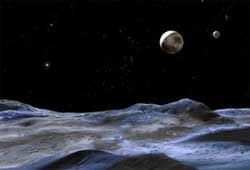|
The Hubble Space Telescope has revealed that Pluto appears to
have not just one, but three moons.
by Dr Tony Phillips
Pluto was discovered
in 1930. The planet resides 3 billion miles from the sun in the
heart of the Kuiper Belt, a vast region of icy, rocky bodies beyond
Neptune's orbit. In 1978, astronomers discovered Charon, Pluto's
only confirmed moon.
"If, as our new
Hubble images indicate, Pluto has not one, but two or three moons,
it will become the first body in the Kuiper Belt known to have more
than one satellite," said Hal Weaver of the Johns Hopkins Applied
Physics Laboratory, Laurel, Md. He is co-leader of the team that
made the discovery.
The candidate moons,
provisionally designated S/2005 P1 and S/2005 P2, are approximately
27,000 miles (44,000 kilometers) away from Pluto--in other words,
two to three times as far from Pluto as Charon.
These are tiny moons.
Their estimated diameters lie between 40 and 125 miles (64 and 200
kilometers). Charon, for comparison, is about 730 miles (1170 km)
wide, while Pluto itself has a diameter of about 1410 miles (2270
km).

Pluto,
as seen from its new moon P1
|
The team plans to make
follow-up Hubble observations in February to confirm that the newly
discovered objects are truly Pluto's moons. Only after confirmation
will the International Astronomical Union consider permanent (and
catchier) names for S/2005 P1 and S/2005 P2.
The Hubble telescope's
Advanced Camera for Surveys observed the two new candidate moons
on May 15, 2005. "The new satellite candidates are roughly
5,000 times fainter than Pluto, but they really stood out in these
Hubble images," said Max Mutchler of the Space Telescope Science
Institute and the first team member to identify the satellites.
Three days later, Hubble
looked at Pluto again. The two objects were still there and appeared
to be moving in orbit around Pluto.
"A re-examination
of [older] Hubble images taken on June 14, 2002 has essentially
confirmed the presence of both P1 and P2 near the predicted locations
based on the 2005 Hubble observations," said Marc Buie of Lowell
Observatory, Flagstaff, Ariz., another member of the research team.

Hubble
pictures show the new moons on the move
|
The team looked long
and hard for other potential moons around Pluto, but they didn't
find any.
"These Hubble
images represent the most sensitive search yet for objects around
Pluto," said team member Andrew Steffl of the Southwest Research
Institute, "and it is unlikely that there are any other moons
larger than about 10 miles across in the Pluto system," he
concludes.
The Hubble Space Telescope is a
project of international cooperation between NASA and the European
Space Agency. The Space Telescope Science Institute in Baltimore
conducts Hubble science operations. The Institute is operated for
NASA by the Association of Universities for Research in Astronomy,
Inc., Washington, under contract with Goddard.
|
